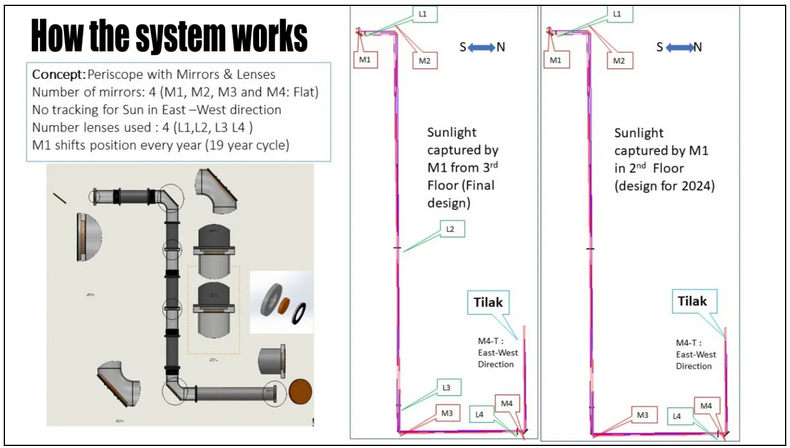News Excerpt:
Recently, On the occasion of Ram Navami, the forehead of Lord Ram’s idol in Ayodhya’s newly-built temple was lit up by a beam of sunlight for a total duration of three minutes, a little after 12 noon.
Key Points:
- A three-minute-long Surya Tilak ceremony — where a beam of sunlight was projected onto the forehead of Lord Ram’s idol — was performed at noon on Wednesday (April 17) in Ayodhya’s newly-built Ram temple, marking the occasion of Ram Navami.
- This was achieved using a special mirror-lens arrangement, designed by astronomers at the Indian Institute of Astrophysics (IIA), Bengaluru, that has been installed in the building by a team from the Central Building Research Institute, Roorkee.
Science behind Surya Tilak
- Step 1: Predict the Sun’s position (each year)
-
- Following the Gregorian calendar, the date of Ram Navami (the Hindu festival celebrating the birth of Lord Ram) varies each year.
- This is because the Gregorian calendar is a solar calendar (based on Earth’s revolution around the Sun — one revolution equals to one year), while the Hindu calendar is a lunar calendar (based on the Moon’s revolution around Earth — one revolution equals to one month).
- A solar year has roughly 365 days, whereas a lunar year is roughly 354 days long.
- Given that the IIA team’s brief was to channelise the sun’s rays such that they fall on the Ram idol’s forehead on Ram Navami, its first task was to calculate the position of the Sun in the sky on that day in any given year.
- Following the Gregorian calendar, the date of Ram Navami (the Hindu festival celebrating the birth of Lord Ram) varies each year.
- Step 2: To channelise the Sun’s rays
- After astronomers estimated where the Sun will be in the sky, their second task was to channelise the sunbeam in a manner that it will fall on the idol’s forehead for a certain amount of time.
About Instruments:
- The IIA team, which began designing the apparatus three years ago, proposed a four-mirror-and-four-lens array for this purpose.
- The first mirror, responsible for receiving the sunlight, has to be positioned at an angle along the path of the sun rays.
- The light will then be reflected to three other mirrors, and will pass through four lenses until it is of the desired intensity, and will be directed to the idol’s forehead.
- The mirrors directed the beams while the lenses made them converge to the required intensity.
Principle behind it:
- This opto-mechanical system operates on a principle similar to that of a periscope — like the ones you used to make for school projects.
- Given that the sun’s position vis-à-vis the first mirror will vary each year, a specially designed 19-gear system was built to make requisite adjustments.
- Once a year, one tooth of the gear will have to be manually turned so that the angle of the pickup mirror (first mirror) is adjusted, and it is ready to capture the Sun’s rays.
- The number 19 was chosen to correspond to the Metonic cycle — a period of 19 years in which there are 235 lunar months, after which the Moon’s phases recur on the same days of the solar year.
- This means that every 19 years, the system will effectively reset, and the cycle will then begin again.

Not the final setup
- The glass tube set-up, housing the lenses and mirrors, runs from the third floor of the temple, all the way to the sanctum sanctorum.
- This huge set-up requires precision handling, and a clean environment to operate.
- The IIA team was especially concerned about the final mirror positioned inside the sanctum sanctorum, where general activity and havans can lead to soot and dust gathering.
- Care must be taken to prevent the fumes (from the sanctum sanctorum) from reaching the final mirror. The lenses and the mirrors should not get clouded.
- This is why the design allows the final mirror to be opened and cleaned, if required.
- Since the construction of the temple is yet to be complete, the installation of the final system has not yet taken place.
- On Wednesday, for the temple’s first Ram Navami celebration, a modified version of the system, having four mirrors and two lenses, was deployed from the second floor of the temple building.


